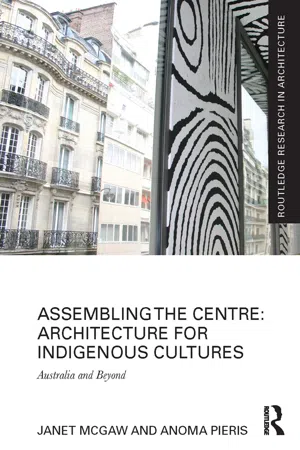
Assembling the Centre: Architecture for Indigenous Cultures
Australia and Beyond
- 224 pages
- English
- ePUB (mobile friendly)
- Available on iOS & Android
Assembling the Centre: Architecture for Indigenous Cultures
Australia and Beyond
About This Book
Metropolitan Indigenous Cultural Centres have become a focal point for making Indigenous histories and contemporary cultures public in settler-colonial societies over the past three decades. While there are extraordinary success stories, there are equally stories that cause concern: award-winning architecturally designed Indigenous cultural centres that have been abandoned; centres that serve the interests of tourists but fail to nourish the cultural interests of Indigenous stakeholders; and places for vibrant community gathering that fail to garner the economic and politic support to remain viable. Indigenous cultural centres are rarely static. They are places of 'emergence', assembled and re-assembled along a range of vectors that usually lie beyond the gaze of architecture. How might the traditional concerns of architecture – site, space, form, function, materialities, tectonics – be reconfigured to express the complex and varied social identities of contemporary Indigenous peoples in colonised nations?
This book, documents a range of Indigenous Cultural Centres across the globe and the processes that led to their development. It explores the possibilities for the social and political project of the Cultural Centre that architecture both inhibits and affords. Whose idea of architecture counts when designing Indigenous Cultural Centres? How does architectural history and contemporary practice territorialise spaces of Indigenous occupation? What is architecture for Indigenous cultures and how is it recognised?
This ambitious and provocative study pursues a new architecture for colonised Indigenous cultures that takes the politics of recognition to its heart. It advocates an ethics of mutual engagement as a crucial condition for architectural projects that design across cultural difference. The book's structure, method, and arguments are dialogically assembled around narratives told by Indigenous people of their pursuit of public recognition, spatial justice, and architectural presence in settler dominated societies. Possibilities for decolonising architecture emerge through these accounts.
Frequently asked questions
Information
Index
- Aboriginal Dance Theatre 192, 193
- Aboriginal Tent Embassy, Canberra 111–114, 185
- exterior 112
- Aboriginal Heritage Act 2006 79
- Aboriginal Protection Act 1869, 1886 20, 76, 159
- activism 53, 112, 190
- Adam, Barbara 100, 105
- aesthetics 121
- alcoholism 137–138
- Allen, Mary Cecil 156
- Anderson, Michael 111
- Aṉangu 27–30
- Anthropocene 70–71
- ARM (Ashton Raggatt McDougall) 153, 170–171, 173
- apology to Aboriginal people 26, 113
- architecture 1–2, 118
- Aboriginal people and 18–19, 110–111, 122, 124, 125, 126, 128–129, 133–134, 146, 153, 154
- critical theory in architectural studies 5–6
- minor 133–134, 185
- performative approaches 100
- representational qualities 152
- art 25–26, 54, 131, 153, 154, 164–165, 169–170, 175–176
- sand stories 155–156
- Arthur, George 142
- assemblages 2, 6, 8–9, 11, 13, 18, 25, 29, 36, 122, 124, 127, 145, 172, 181, 188
- Atwood, Bain 24
- Australia Day 111
- Baker, Thomas 49
- Bamblett, Lawrence 25, 182
- Bangerang Cultural Centre, Shepparton 42...
Table of contents
- Cover Page
- Half Title Page
- Title Page
- Copyright Page
- Table of Contents
- List of figures
- Acknowledgements
- Introduction: cultural centres, identity, assemblages
- Voices: Story, writing, exchange
- Centre: space, politics, typology
- Land: belonging, law, rights
- Programme: dreaming, timekeeping, becoming
- (Im)materialities: clearing, erasure, disguise
- Skin: (s)crypts, inscriptions, hide
- Conclusion: re-assembling the Indigenous cultural centre
- Index